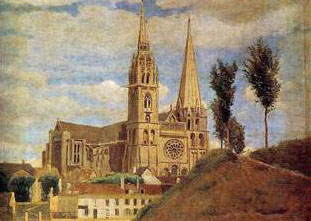Architecture and Hope
The funeral of Dr. Dorothy Kingery, a lover of the great Gothic cathedral of Chartres, prompted this reflection.
“Oh! I have slipped the surly/bonds of Earth/And danced the skies on/laughter-silvered wings;/Sunward I’ve climbed, and / joined the tumbling mirth of sun-split clouds…” It’s not just the stained glass of a Gothic cathedral like Chartres that tells the story of Christ; the entire building is a kind of image of the gospel. For the architecture of the gothic cathedral – the architecture of pinnacle, spire and steeple, pointed arch and gable, of gravity-defying vault and flying buttress, of soaring colonnettes and lacelike traceries of stone – is architecture that seeks to escape the downward pull of gravity, and to dissolve matter in light. It is architecture “after an heavenly and spiritual manner”, or, to borrow the words of the aviator poet John Gillespie Magee (quoted above), it is architecture that has “slipped the surly bonds of earth”; in which matter has been liberated from all that is dark and heavy to become a vehicle of light and freedom. Such architecture is an image of the spiritual body of the resurrection, an image of human nature delivered from all that is dark and heavy– physically, morally, and spiritually– and become translucent to the light of the Spirit. As the ancient preface for the departed puts it, in words borrowed from 2 Corinthians 5:1, “to thy faithful people, O Lord, life is changed, not taken away: and at the dissolution of the tabernacle of this earthly sojourning a dwelling-place eternal is made ready in the heavens”.
Moreover, as the great architectural historian John Summerson pointed out, the Gothic is an architecture about architecture – an architecture whose basic unit or form is the aedicule, the “little shrine” complete with columns and pediment that marks the indwelling presence of a saint, but multiplied and combined, scaled up and down, in endless variation, so that the entire building consists of nothing but aedicules; the whole house of God is comprised of a multitude of individual houses of God’s elect. As such, it is an image of the spiritual temple, built up of living stones (1 Peter 2:5); of the body of Christ, a unity comprised of many individual members (Romans 12:5); of a city, the heavenly Jerusalem, “which is at unity in itself”, where God dwells among the people he has redeemed, whose sorrows he turns into joy (Psalm 122). For, on the eve of his own death, Christ spoke to his disciples of a home for them with God: “In my Father’s house are many mansions: if it were not so, I would have told you. I go to prepare a place for you. And if I go and prepare a place for you, I will come again, and receive you unto myself; that where I am, there ye may be also” (St. John 14:2-3). As in the great medieval summae, those systematic syntheses of classical and Christian learning, of reason and revelation, so in the Gothic cathedral, all the parts are drawn into ordered and harmonious relation to the whole. The Gothic cathedral is image in architecture of all creatures cohering in Christ and of being built up into his body as living members, of all things returning into unity in him by whom all things were made.
In one of Dorothy’s short stories (“A Handsome Couple”), she wrote about losses as “a constant part of life’s rebuilding” and the conviction that “nothing we truly love is ever lost”. That “losses” should contribute to the “rebuilding”, that death should be the means of life, and present sorrow only increase our final joy; that we might not only regain all that we have loved and lost, but also advance to what we never had, to what is “truly loved” because truly worthy of love – this is what is accomplished in the resurrection. Perhaps this seems too much to hope for, perhaps it seems too good to be true – yet if it is not true, then all our aspirations to beauty and truth, all our hopes for justice and love, are merely illusions, delusions, deceptions, and all our endeavours are in vain. Is that really what we think? If there is a God, infinite in goodness, wisdom, and power, the Maker and Preserver of all things, then there is nothing more likely than that he should raise the dead. The one who brought the world out of chaos and light out of darkness can most certainly bring life out of death. Perhaps this does seem too much to hope for. Perhaps because, like the soaring vaults of the Gothic cathedral, it is out of reach to us who are held by “the surly bonds of earth” and cannot “dance the skies” like the poet’s aviator. But the Gothic cathedral is a sign that the Lord most high made his home among us who are most low precisely that we may be at home with him. He has departed from us only to prepare a place for us in the Father’s house, and he promises to return to take us to himself, that where he is there we may be also. In him are we set free to “dance the skies”.
This essay by Fr. Gavin Dunbar was published in St. John’s Parish Paper on May 21, 2023. Image: WikiArt.org, Chartres Cathedral by Camille Corot (1830).




